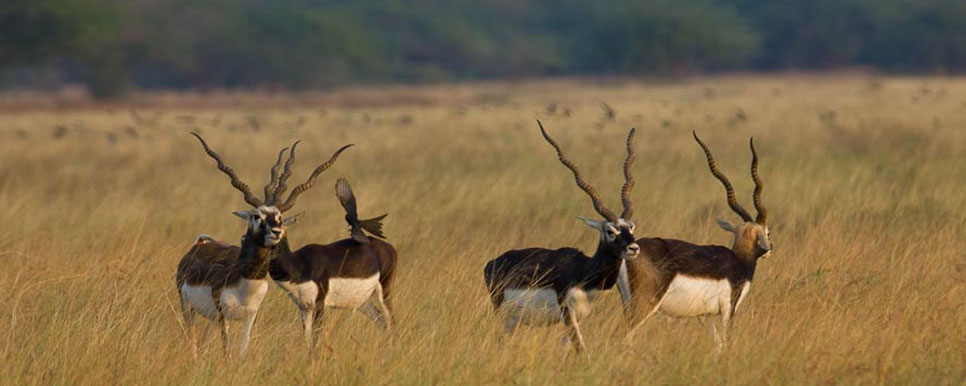Blackbucks at Velavadar - Facts You Need to Know

Velavadar Blackbuck National Park is a hidden gem in true essence in Gujarat, tucked away in the district of Bhavnagar. Velavadar National Park is a distinctive grassland ecosystem, primarily designated to preserve the endangered blackbucks. Each year, migratory birds from Siberia, Europe, and Central Asia seek refuge in Velavadar National Park, evading adverse weather conditions. Notably, the park's wetland, nestled in its southern region, serves as a magnet for a diverse array of migratory birds including flamingos, pelicans, waders, ducks, white storks, coots, sarus cranes, and painted storks. Renowned among bird enthusiasts, Velavadar also hosts sightings of common cranes, demoiselle cranes, as well as raptors like greater spotted eagles and steppe eagles.
The grassland's charm is accentuated by the graceful movements of blackbucks and blue bulls, visible even from afar. Within this habitat, sizable herds of blackbucks stand out prominently. These majestic creatures exhibit less timidity towards humans here, offering ample opportunities to witness their natural behaviours: leaping, running, grazing, drinking from watering holes, engaging in rutting displays, and joyfully chasing one another. The herds comprise various gender compositions, including mixed groups of males and females, all-male assemblies, and all-female gatherings. Jeep safari, walking safari and bird watching are the best things to do in the Blackbuck National Park.
Blackbucks, the Star Attractions of Velavadar - Aspects to Acknowledge • What are Blackbucks?The Blackbuck, scientifically referred as Antilope cervicapra, is an endangered antelope exclusive to India and Nepal. Renowned for their slender and graceful build, they boast pointed, delicate hooves, narrow muzzles resembling those of sheep, and short tails. Notably, only males possess horns. Their colouration varies by gender, with males sporting rich dark brown backs, sides, and outer leg areas, while females exhibit a yellowish hue in these regions. Both genders feature white underparts, including the insides of their legs, and a distinctive white eye ring. Throughout their lives, male blackbucks progressively darken, with their horns displaying a spiral pattern, ringed at the base and twisted up to four turns. Classified as "Nearly Threatened" by the IUCN List, blackbucks benefit from stringent protection laws, notably listed under Schedule I of the Wildlife Protection Act of 1972. Numerous national parks have undertaken robust conservation efforts to safeguard this species.
Lifestyle and Social BehaviourBlackbuck National Park are highly social creatures, forming herds ranging from 5 to 50 individuals. These herds typically adopt a harem structure, comprising an adult male along with numerous females and their offspring. During cooler seasons, blackbucks are primarily active during the day, while in hotter periods, they tend to rest in shaded areas, reserving their activity for the mornings and late afternoons. Displaying caution and shyness, blackbucks rely on their keen eyesight to detect potential threats and respond promptly. Although they lack a strong sense of smell or hearing, their sharp vision enables them to evade dangers efficiently. In the face of danger, a blackbuck will leap into the air and swiftly flee, with the entire herd to escape the pursuit.
Blackbucks adhere to a polygynous mating system, where a single male mates with multiple females. During the mating season, males establish and fiercely defend their territories against competing males, often engaging in vocal displays and horn-based combat. While blackbucks are capable of mating throughout the year, the peak conjugal periods occur from March to April and August to October. Following a gestation period of six months, females give birth to a single offspring. Remarkably, newborn blackbucks can run shortly after birth and spend over a year alongside their mothers. Males typically attain reproductive maturity at three years of age, while females begin breeding slightly earlier, at around two years old.
The Habitat of BlackbucksBlackbucks primarily inhabit open grasslands, dry scrublands, and sparsely wooded regions, often favouring areas with consistent access to water throughout the year. Due to their intolerance to cold climates, they are commonly found in desert regions such as Rajasthan and coastal areas. Additionally, they thrive in the foothills of the Himalayas, where the climate is moderate and the jungles are not densely packed. In India, their presence is most prominent in states like Gujarat, Punjab, Rajasthan, and Haryana. Renowned for their remarkable speed, blackbucks are regarded as one of the fastest land animals on the planet.
DietThe blackbuck, a herbivorous species, primarily grazes on low grasses but occasionally browses on vegetation. At the Velavadar Black Buck Sanctuary, Dichanthium annulatum constitutes approximately 35% of their diet. Summer consumption of crude protein falls significantly below recommended levels, with Blackbucks consuming less food overall compared to winter, occasionally supplementing their diet with fruits from Prosopis juliflora.